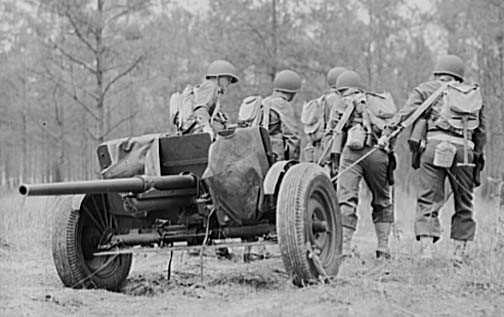
| Year | August 1937 |
| Weapon Type | [@type] |
| Origin & Designer | [@designer] |
| Numbers Produced | 18.702 |
| Crew | Corporal/Squad Leader + .30 M1 Carbine. Pvt/Gunner + .30 M1 Carbine. Pvt/Assistant Gunner + .30 M1 Carbine. 2 x Pvts/Ammo Bearers + .30 M1 Carbines. 2 x Pvts/Drivers + .30 M1 Rifles (Towing Vehicles). |
| Calibre | 37mm (37x223) |
| Elevation | -10° to +15° |
| Traverse | 60° |
| Breech | Semi-Automatic/Vertical Block |
| Recoil | Hydrospring |
| Gun Sight | M40 |
| Gun Mount | [@gun_mounts] |
| Carriage | M4: Split Trail |
| Trailers | [@trailers] |
| Gun Shield | 6.35mm |
| Armoured Plate | [@armoured_plate] |
| Barrel Length | 2.1m (L/57) |
| Overall Length | 3.92m |
| Width | [@width] |
| Height | [@height] |
| Weight | 413.68 kg |
| Round Weight | APC (M51) 1.579 kg. HE (M63) 1.420 kg. |
| Muzzle Velocity | APC (M51B) 554 m/s. HE (M63) 792 m/s. |
| Feed | [@feed] |
| Magazine Capacity | [@magazine_capacity] |
| Practical Rate of Fire | [@practical_rate_of_fire] |
| Rate of Fire | [@rate_of_fire] |
| Maximum Rate of Fire | 25 r.p.m. |
| Maximum Ceiling | [@maximum_ceiling] |
| Maximum Ground Range | [@maximum_ground_range] |
| Maximum Range | APC: 6.858m HE: 11.704m Canister: |
| Armour Penetration | 58mm @ 500m @ 30° 50mm @ 1000m @ 30° |
| Traction | Willys Jeep & Dodge Trucks |
| Variants | [@variants] |
| Notes | In the 1930s the US army was looking to up-grade their anti-tank units, up to then the standard anti-tank weapon was the .50 cal heavy machine gun and events in the Spanish civil war had given them cause for concern. After evaluating two German 37mm Pak 36s they decided on a similar calibre. After tests with different carriages and guns they finally agreed on the M3 37mm. Standardized in 1940 the M3 became the standard Anti-Tank Gun of the U.S. Ground Forces in the early part of WW2. The gun itself was light in weight and its standard AP round could penetrate around 58mm of armour at a range of 500m. It could also fire HE and canister rounds. In 1942 the Germans began to improve the frontal armour of their mark III and IV tanks, in which the M3 struggled to penetrate, later the heavier Tiger and Panthers would be immune to the M3 and this was highlighted during the Sicilian campaign. By this time the US army had decided to replace the M3 with the 57mm M1. Due to its light weight it was kept in use in the Pacific theatre as an Infantry Gun, and could be useful in firing canister shot to devastating effect to break up Japanese Infantry attacks. |